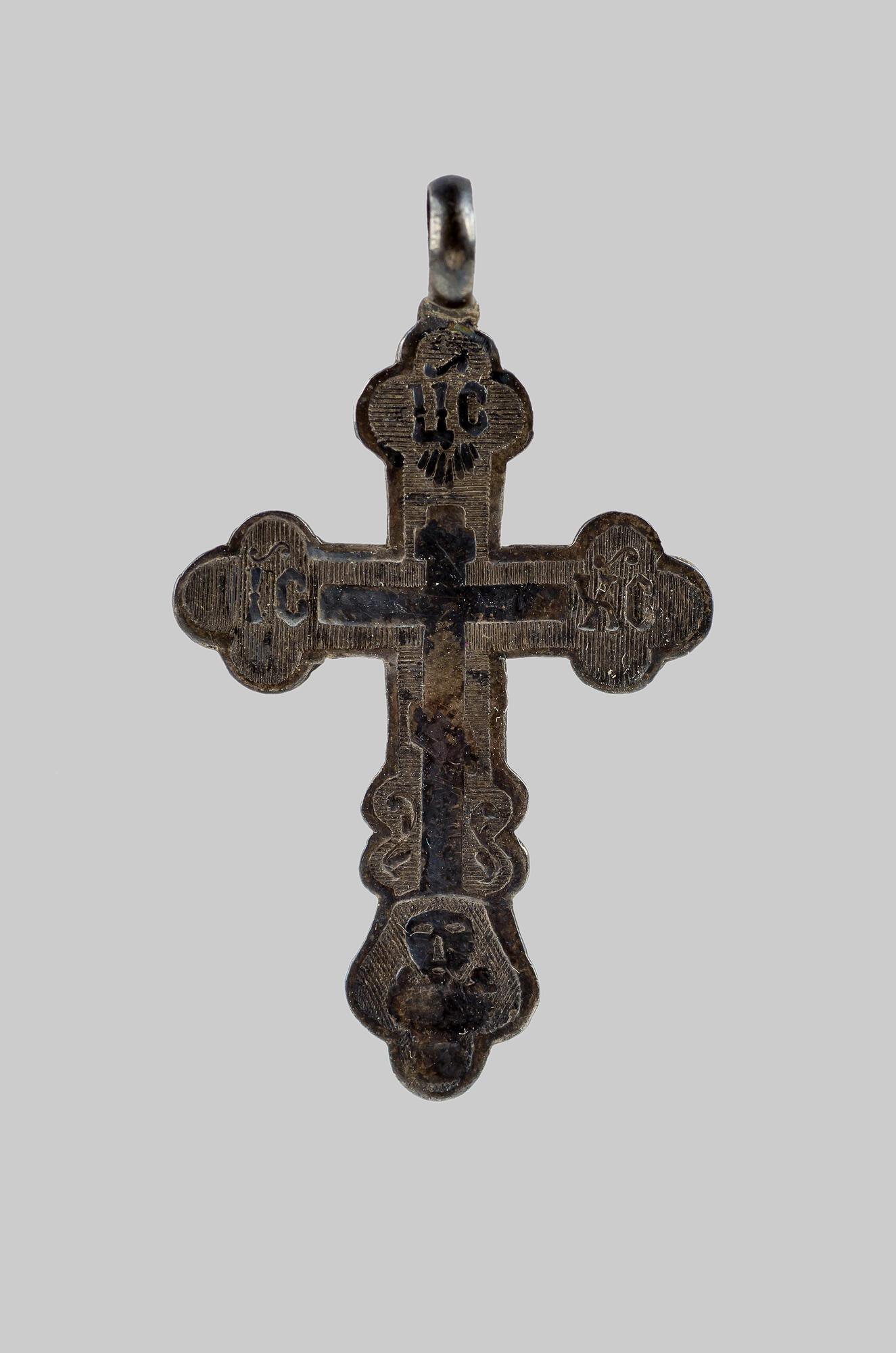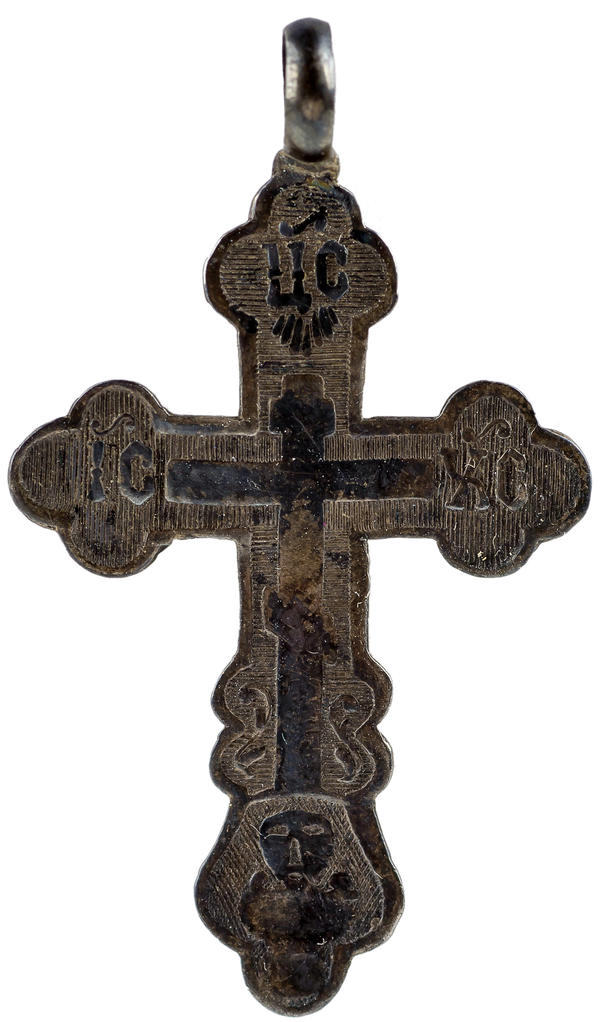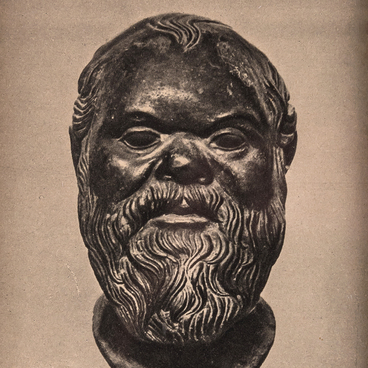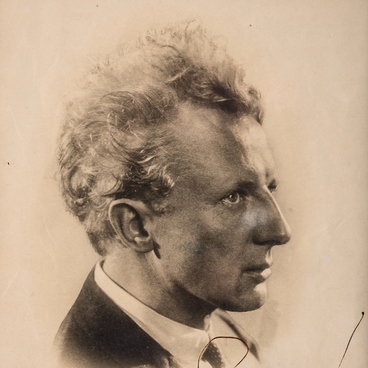Sergei Eisenstein was born in RIga on January 22, 1898. He was probably baptized with this baptismal cross. Most likely, the director no longer wore it in the Soviet years. The cross was kept in one of the drawers of a writing cabinet in his bedroom. In the 1920s and 1930s, there was a combat against religion, and the authorities closed and destroyed churches. It became unsafe to openly practice religion. Sergei Eisenstein wrote in his memoirs that he was religious in his childhood and youth, but in 1916, even before the revolution, he withdrew from the rites. However, despite his secularism Eisenstein’s understanding of the very essence of Christianity did not leave him.
An Orthodox cross is depicted above the symbol of Calvary. At its three ends there are Church Slavonic letters ‘IС ХС ЦС’ meaning ‘Jesus Christ the King of Glory’. On the back of the cross, there is a manufacturer’s stamp: a rowing boat. Such stamping was used by the workshops of the village Krasnoye (Kostroma guberniya) in the late 19th century Eisenstein’s baptismal sock is exhibited next to it. The socks were sent to Pskov to the family of his father’s cousin, Nikolay Eisenstein, at the birth of the director’s cousin, also Sergei. Sergei Eisenstein, then a teenager, could even play the role of godfather. One of the socks was lost before the war. Sergei Nikolaevich’s widow brought the second one to S.M. Eisenstein’s Scientific Memorial Study in the early 1970s before she emigrated to the United States with her daughter. We do not know much about Sergei Nikolaevich. Seeing him off to the war in 1941, the director told his cousin: ‘Remember who you are named after.’ Both of them were baptized in honor of St. Sergius of Radonezh. In 1942, Sergei Nikolaevich was arrested and repressed at the front.
The custom engraved merit badge of Mikhail Eisenstein, the father of the future film director, from the MariInsky Barracks Hospital. There is a red enamel cross in a drop-shaped frame, decorated with an imperial crown and a monogram ‘MP’. On the reverse side of the crown there is a ring for sign fastening. On the back there is an engraved inscription: ‘M.O. Eisenstein 1905’. The badge was awarded to MikhaIl OsipOvich for his charitable activity. In 1916, Mikhail Eisenstein was granted the hereditary nobility in recognition of his charitable work and for the rank of real state councilor.
An Orthodox cross is depicted above the symbol of Calvary. At its three ends there are Church Slavonic letters ‘IС ХС ЦС’ meaning ‘Jesus Christ the King of Glory’. On the back of the cross, there is a manufacturer’s stamp: a rowing boat. Such stamping was used by the workshops of the village Krasnoye (Kostroma guberniya) in the late 19th century Eisenstein’s baptismal sock is exhibited next to it. The socks were sent to Pskov to the family of his father’s cousin, Nikolay Eisenstein, at the birth of the director’s cousin, also Sergei. Sergei Eisenstein, then a teenager, could even play the role of godfather. One of the socks was lost before the war. Sergei Nikolaevich’s widow brought the second one to S.M. Eisenstein’s Scientific Memorial Study in the early 1970s before she emigrated to the United States with her daughter. We do not know much about Sergei Nikolaevich. Seeing him off to the war in 1941, the director told his cousin: ‘Remember who you are named after.’ Both of them were baptized in honor of St. Sergius of Radonezh. In 1942, Sergei Nikolaevich was arrested and repressed at the front.
The custom engraved merit badge of Mikhail Eisenstein, the father of the future film director, from the MariInsky Barracks Hospital. There is a red enamel cross in a drop-shaped frame, decorated with an imperial crown and a monogram ‘MP’. On the reverse side of the crown there is a ring for sign fastening. On the back there is an engraved inscription: ‘M.O. Eisenstein 1905’. The badge was awarded to MikhaIl OsipOvich for his charitable activity. In 1916, Mikhail Eisenstein was granted the hereditary nobility in recognition of his charitable work and for the rank of real state councilor.



